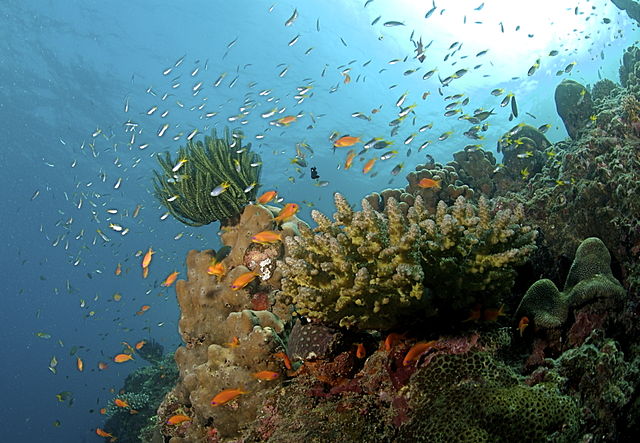 |
| Biodiversity: Definition, Distribution, Importance and Conservation |
Distribution
Biodiversity is not evenly spread across the globe. It varies from place to place. On land, it is usually greater near the equator and on aquatic regions, it is highest near coral reefs. In terms of geopolitical regions, Brazil leads the chart along with the USA, China and the Philippines. There is a total of 16 megadiverse countries identified by Conversation International.
Latitudinal Gradient
It is observed that biodiversity increases as one move from the poles to the tropics. This phenomenon of increase in biodiversity on the latitudinal pattern is often referred as the latitudinal gradient or latitudinal diversity gradient (LDG). There are several factors behind the LDG, but the temperature is considered as the most important factor. However, recent studies challenge this notion, as marine life do not completely follow this phenomenon.
Biodiversity Hotspots
Biodiversity hotspot refers to a biogeographic region with a significantly higher level of biodiversity whose eco-balance is threatened by human activities. It was first defined by the British environmentalist Norman Myers in 1988. Today, there are 36 biodiversity hotspots being identified across the globe which host nearly 60 per cent of all life on Earth. Moreover, the majority of these species are endemic which means these species cannot be found anywhere else. To qualify as a biodiversity hotspot under Myers 2000, it must contain at least 0.5 per cent or 1500 endemic species of vascular plants and have lost at least 70 per cent of its primary vegetation.
There are many similar programmes to identify and conservation species are being initiated by international agencies. Global 200 ecoregions by World Wide Fund for Nature (WWF) and Endemic Bird Areas (EBAs) by Birdlife International are prime examples of such initiatives.
Species-Area Relationship
The species-area relationship or species-area curve is the mathematical or graphical representation of the relationship between species and habitat area. It is normally constructed for a particular type of organism such as plants, birds or animals who share the same trophic levels.
On a logarithmic scale, the relationship is a straight line described by the equation
log S = log C + Z log A
where S is the species richness; A is the sampled Area; Z is the regression coefficient and C is the Y-intercept.
The value of Z remains between 0.1 and 0.2 on a small scale, but if we scale up the area on the continental level, the Z value is in between 0.6 and 1.2.
Biodiversity Loss
According to the International Union for Conservation of Nature (IUCN), we have lost 784 species (which include 338 vertebrates, 359 invertebrates and 87 plants) in the last 500 years. Dodo (Mauritius), Quagga (Africa), Passenger Pigeon (North America) and Tasmanian tiger (Australia) are the prominent examples of this phenomena. Even in the last 20 years, there are 27 species which have disappeared from the earth. There are numerous species which have disappeared from Earth and not being ever documented. As of 2018, IUCN Red List put 26,197 species on threatened species watch. Out of which 20 per cent species are classified as critically endangered with high chances of extinction.
Cause of Biodiversity Loss
1. Habitat Loss: In the past few years, humans have cleared forest and destroyed critical bioecological zones in the name of development. This has caused loss of habitat for many species.
2. Overexploitation: We have lost many species due to overexploitation by humans. Stellar's sea cow and Passenger Pigeon are two prime victims of human greed in recent history.
3. Invasion of alien species: When an alien species deliberately or unintentionally introduced in a habitat, it can cause decline or extinction of indigenous species. The introduction of cats has caused the extinction of six endemic and more than 70 local subspecies of birds in New Zealand.
4. Coextinctions: When a species extinct from nature, it can lead to the extinction of several dependent species.
Importance of Biodiversity
The ignorant minds may dismiss biodiversity as a fancy term, but not maintaining and conserving the biodiversity have certain implications. As despite all our scientific and technological advances, we heavily rely on our environment and other species for our living and welfare. It is proved by many controlled experiments that removal of a certain organism can lead to the destruction of the whole ecosystem. Some of the important reasons for maintaining biodiversity are
1. Increase ecosystem primary productivity
2. Protect natural resources
3. Protect soil and promote soil formation
4. Help in controlling the pollution
5. Help in speedy recovery from natural disaster
6. Provide more food
7. Provide more medicines and other health products
Biodiversity Conservation Techniques
There are two major approaches adopted to conserve the biodiversity, namely, In situ (on site) and Ex site (off-site).
In situ Conservation
When an entire region is conserved and protected to save the species, it is known as the In situ approach. This is done by protecting and conserving biogeographically important regions.
In India, these regions are legally protected as biosphere reserves, national parks, and wildlife sanctuaries. As of 2018, India has 18 biosphere reserves, 104 national parks and 543 wildlife sanctuaries. India has also extended the legal protection to the community or privately maintained reserves and sanctuaries under Wildlife Protection Amendment Act 2002.
Ex Situ Conservation
In Ex situ conservation, threatened species are taken out from their natural habitats and placed in a protected environment. There are numerous organizations such as zoological parks, botanical gardens, gene banks and seed banks are working together for ex situ biodiversity conservation. Indian Monocarpic Palm and Pallassana Spurge are two such plant species which are extinct in wild but exist due to ex situ conservation efforts made by scientists and environmentalists.
Source: NCERT Class 12 Biology
Further Reading:
1. Ecology: Organisms and Population
2. Extinct Plant Species of India
